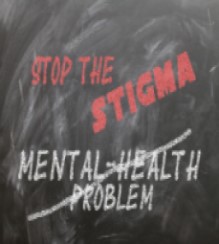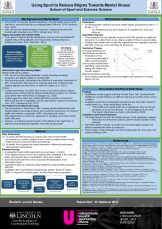By Janine Blades //
 Around 75% of mental illness is onset by the age of 24 with approximately 20% of students worldwide experiencing a mental health concern every year due to heightened susceptibility to stressors during this time (Auerbach et al., 2016; Hill et al., 2018, Kessler et al., 2005). Although many mental health support services are widely accessible to students, only 16% of this subgroup receive or seek treatment, partly due to the stigma associated with mental health (Auerbach et al., 2016; Clement et al., 2015).
Around 75% of mental illness is onset by the age of 24 with approximately 20% of students worldwide experiencing a mental health concern every year due to heightened susceptibility to stressors during this time (Auerbach et al., 2016; Hill et al., 2018, Kessler et al., 2005). Although many mental health support services are widely accessible to students, only 16% of this subgroup receive or seek treatment, partly due to the stigma associated with mental health (Auerbach et al., 2016; Clement et al., 2015).
 Stigma towards mental health comes in three forms: public stigma; personal stigma and self-stigma. Negative stereotypes and attitudes towards those who experience or seek help for mental illness may be internalised resulting in reduced help-seeking intentions by those who require it (Pedersen & Paces, 2014; Vogel et al., 2007). Therefore, our UROS project was centred on evaluating a novel method for targeting stigma towards mental health.
Stigma towards mental health comes in three forms: public stigma; personal stigma and self-stigma. Negative stereotypes and attitudes towards those who experience or seek help for mental illness may be internalised resulting in reduced help-seeking intentions by those who require it (Pedersen & Paces, 2014; Vogel et al., 2007). Therefore, our UROS project was centred on evaluating a novel method for targeting stigma towards mental health.
Our Research
During this summer of sport, Dr Matt Bird and myself set out to examine the recent documentary A Royal Team Talk: Tackling Mental Health and its effectiveness at reducing stigma among undergraduate university students. The documentary included elite footballers discussing their experiences of mental health with Prince William and listening to the mental health experiences of amateur players. The intergroup contact between these individuals (e.g., professional and amateur athletes who have experienced mental illness), along with the mental health literacy content, demonstrate similarities to specific controlled interventions designed to reduce stigma towards mental health, Therefore, our aims were to determine how efficacious and influential these factors were within this video-based setting.
For our project, a mixed methods design was implemented as demonstrated in Figure 1. Participants completed quantitative measures which included three surveys assessing stigma and interviews were conducted with those in the intervention group.
Figure 1. Methods design for the study.
Timeline
Figure 2. Originally planned timeframe.
Figure 3. Adapted project timeline.
(Study will continue till we reach the full participant sample).
Findings and Conclusion
Data from 10 undergraduate students showed that the intervention and control condition had similar influences on personal, perceived public, and self-stigma across the three time points. Findings from the qualitative data showed a better understanding of mental illness and methods to tackle it was gained from watching the documentary. These findings suggest that the documentary may not influence stigma but could enhance mental health literacy. Future research, therefore, may measure the effect of this documentary on mental health literacy components and how these relate to stigma.
Reflecting on the Experience
The greatest challenge we faced was recruitment as over an hour was required from participants and we were limited to recruitment via social media. Even with an extended time frame (see Figure 2 and Figure 3), we only reached a third of the desired number which unfortunately left our findings underpowered. Overcoming disheartened feelings, I learnt that a wide recruitment platform is useful along with resilience for when things don’t go to plan.
The opportunity to contribute to the universities ongoing research and work collaboratively with a knowledgeable and supportive supervisor like Matt was a privilege. I developed greater confidence in my writing abilities through constructive feedback along with enhanced critical thinking as I contributed to the project workload. Although there were stressful situations and setbacks, I have developed strength and durability from the experience that will support me through my third year of study and equip me for future employment opportunities.
*To view Janine’s research poster and presentation recording, please click on the thumbnails below: 
References
Auerbach, R. P., Alonso, J., Axinn, W. G., Cuijpers, P., Ebert, D. D., Green, J. G., … & Bruffaerts, R. (2016). Mental disorders among college students in the World Health Organization world mental health surveys. Psychological Medicine, 46, 2955-2970.
Clement, S., Schauman, O., Graham, T., Maggioni, F., Evans-Lacko, S., Bezborodovs, N., … & Thornicroft, G. (2015). What is the impact of mental health-related stigma on help-seeking? A systematic review of quantitative and qualitative studies. Psychological Medicine, 45, 11-27.
Hill, M. R., Goicochea, S., & Merlo, L. J. (2018). In their own words: Stressors facing medical students in the millennial generation. Medical Education Online, 23, 1530558.
Kessler, R. C., Berglund, P., Demler, O., Jin, R., Merikangas, K. R., & Walters, E. E. (2005). Lifetime prevalence and age-of-onset distributions of DSM-IV disorders in the National Comorbidity Survey Replication. Archives of General Psychiatry, 62, 593-602.
Pedersen, E.R., & Paves, A.P. (2014). Comparing perceived public stigma and personal stigma of mental health treatment seeking in a young adult sample. Psychiatry Research, 219(1), 143-150. https://doi.org/10.1016/j.psychres.2014.05.017
Vogel, D.L., Wade, N.G., & Hackler, A.H. (2007). Perceived public stigma and the willingness to seek counselling: The mediating roles of self-stigma and attitudes toward counselling. Journal of Counselling Psychology, 54(1), 40-50. http://dx.doi.org/10.1037/0022-0167.54.1.40